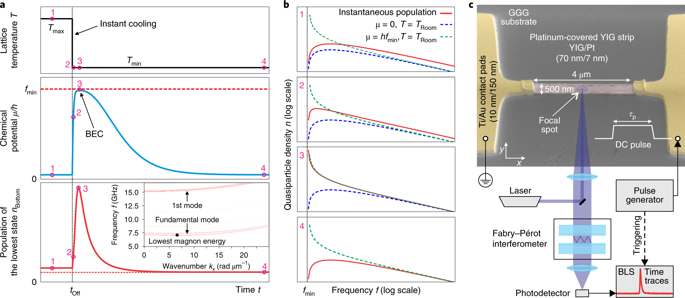当前位置:
X-MOL 学术
›
Nat. Nanotechnol.
›
论文详情
Our official English website, www.x-mol.net, welcomes your
feedback! (Note: you will need to create a separate account there.)
Bose-Einstein condensation of quasiparticles by rapid cooling.
Nature Nanotechnology ( IF 38.1 ) Pub Date : 2020-04-20 , DOI: 10.1038/s41565-020-0671-z Michael Schneider 1 , Thomas Brächer 1 , David Breitbach 1 , Viktor Lauer 1 , Philipp Pirro 1 , Dmytro A Bozhko 2 , Halyna Yu Musiienko-Shmarova 1 , Björn Heinz 1, 3 , Qi Wang 1, 4 , Thomas Meyer 1, 5 , Frank Heussner 1 , Sascha Keller 1 , Evangelos Th Papaioannou 1, 6 , Bert Lägel 7 , Thomas Löber 7 , Carsten Dubs 8 , Andrei N Slavin 9 , Vasyl S Tiberkevich 9 , Alexander A Serga 1 , Burkard Hillebrands 1 , Andrii V Chumak 1, 4
Nature Nanotechnology ( IF 38.1 ) Pub Date : 2020-04-20 , DOI: 10.1038/s41565-020-0671-z Michael Schneider 1 , Thomas Brächer 1 , David Breitbach 1 , Viktor Lauer 1 , Philipp Pirro 1 , Dmytro A Bozhko 2 , Halyna Yu Musiienko-Shmarova 1 , Björn Heinz 1, 3 , Qi Wang 1, 4 , Thomas Meyer 1, 5 , Frank Heussner 1 , Sascha Keller 1 , Evangelos Th Papaioannou 1, 6 , Bert Lägel 7 , Thomas Löber 7 , Carsten Dubs 8 , Andrei N Slavin 9 , Vasyl S Tiberkevich 9 , Alexander A Serga 1 , Burkard Hillebrands 1 , Andrii V Chumak 1, 4
Affiliation

|
The fundamental phenomenon of Bose-Einstein condensation has been observed in different systems of real particles and quasiparticles. The condensation of real particles is achieved through a major reduction in temperature, while for quasiparticles, a mechanism of external injection of bosons by irradiation is required. Here, we present a new and universal approach to enable Bose-Einstein condensation of quasiparticles and to corroborate it experimentally by using magnons as the Bose-particle model system. The critical point to this approach is the introduction of a disequilibrium of magnons with the phonon bath. After heating to an elevated temperature, a sudden decrease in the temperature of the phonons, which is approximately instant on the time scales of the magnon system, results in a large excess of incoherent magnons. The consequent spectral redistribution of these magnons triggers the Bose-Einstein condensation.
中文翻译:

快速冷却使准粒子的玻色-爱因斯坦凝聚。
玻色-爱因斯坦凝聚的基本现象已经在不同的真实粒子和准粒子系统中观察到。真实粒子的凝结是通过大幅降低温度来实现的,而对于准粒子,则需要通过辐射从外部注入玻色子的机制。在这里,我们提出了一种新的通用方法,可以使准粒子发生玻色-爱因斯坦凝聚,并通过使用磁振子作为玻色粒子模型系统来实验性地证实它。这种方法的关键点是引入了声子浴,使磁振子失衡。加热到高温后,声子温度突然下降,这在磁振子系统的时间范围内大约是瞬间,导致非相干磁振子的大量过量。
更新日期:2020-04-24
中文翻译:

快速冷却使准粒子的玻色-爱因斯坦凝聚。
玻色-爱因斯坦凝聚的基本现象已经在不同的真实粒子和准粒子系统中观察到。真实粒子的凝结是通过大幅降低温度来实现的,而对于准粒子,则需要通过辐射从外部注入玻色子的机制。在这里,我们提出了一种新的通用方法,可以使准粒子发生玻色-爱因斯坦凝聚,并通过使用磁振子作为玻色粒子模型系统来实验性地证实它。这种方法的关键点是引入了声子浴,使磁振子失衡。加热到高温后,声子温度突然下降,这在磁振子系统的时间范围内大约是瞬间,导致非相干磁振子的大量过量。











































 京公网安备 11010802027423号
京公网安备 11010802027423号